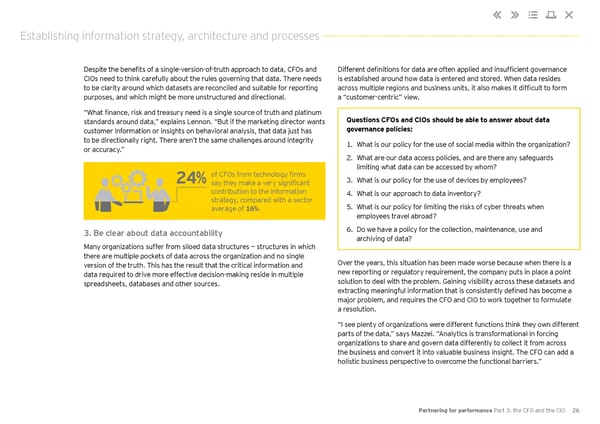Establishing information strategy, architecture and processes Despite the benefits of a single-version-of-truth approach to data, CFOs and Different definitions for data are often applied and insufficient governance CIOs need to think carefully about the rules governing that data. There needs is established around how data is entered and stored. When data resides to be clarity around which datasets are reconciled and suitable for reporting across multiple regions and business units, it also makes it difficult to form purposes, and which might be more unstructured and directional. a “customer-centric” view. “What finance, risk and treasury need is a single source of truth and platinum standards around data,” explains Lennon. “But if the marketing director wants Questions CFOs and CIOs should be able to answer about data customer information or insights on behavioral analysis, that data just has governance policies: to be directionally right. There aren’t the same challenges around integrity 1. What is our policy for the use of social media within the organization? or accuracy.” 2. What are our data access policies, and are there any safeguards limiting what data can be accessed by whom? 24%of CFOs from technology firms 3. What is our policy for the use of devices by employees? say they make a very significant contribution to the information 4. What is our approach to data inventory? strategy, compared with a sector 5. What is our policy for limiting the risks of cyber threats when average of 16%. employees travel abroad? 3. Be clear about data accountability 6. Do we have a policy for the collection, maintenance, use and archiving of data? Many organizations suffer from siloed data structures — structures in which there are multiple pockets of data across the organization and no single Over the years, this situation has been made worse because when there is a version of the truth. This has the result that the critical information and new reporting or regulatory requirement, the company puts in place a point data required to drive more effective decision-making reside in multiple solution to deal with the problem. Gaining visibility across these datasets and spreadsheets, databases and other sources. extracting meaningful information that is consistently defined has become a major problem, and requires the CFO and CIO to work together to formulate a resolution. “I see plenty of organizations were different functions think they own different parts of the data,” says Mazzei. “Analytics is transformational in forcing organizations to share and govern data differently to collect it from across the business and convert it into valuable business insight. The CFO can add a holistic business perspective to overcome the functional barriers.” Partnering for performance Part 3: the CFO and the CIO 26
 Partnering for Performance Part 3 Page 25 Page 27
Partnering for Performance Part 3 Page 25 Page 27